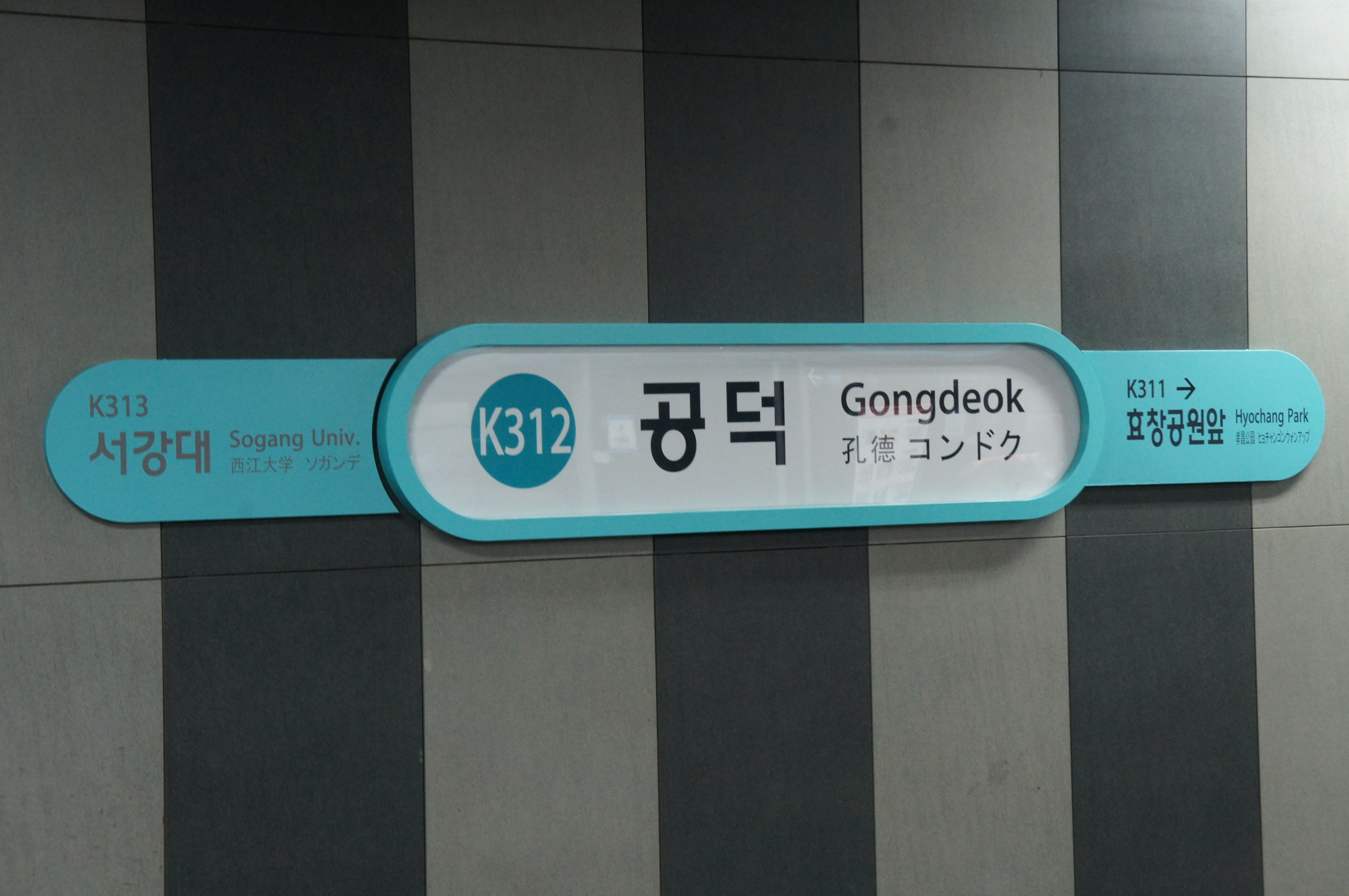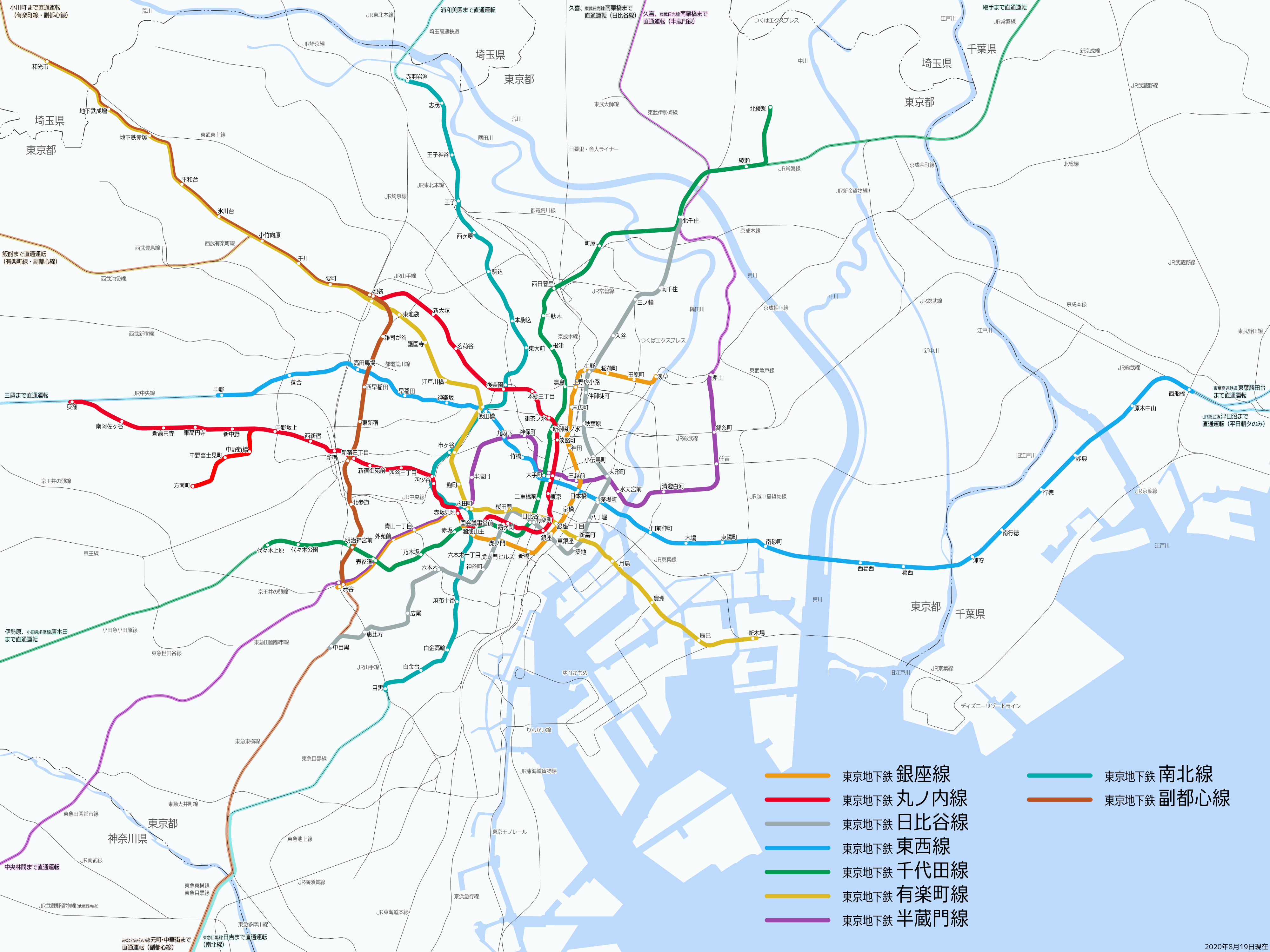|
Meguro Station
is a railway station in the Kamiōsaki, Shinagawa, Tokyo, Kamiōsaki district of Shinagawa, Tokyo, close to the boundary with Meguro ward. Lines Meguro Station is served by the following lines: *East Japan Railway Company (JR East) Yamanote Line *Tokyo Metro Namboku Line - through service with Tokyu Meguro Line *Toei Mita Line - through service with Tokyu Meguro Line *Tokyu Meguro Line - through service with Tokyo Metro Namboku Line and Toei Mita Line Station layout The JR East part of the station consists of one island platform serving two tracks. It also has a "Midori no Madoguchi" staffed ticket office and a View Plaza travel agency. The combined Tokyu, Tokyo Metro, and Toei part of the station consists of an island platform located on the 4th basement ("4BF") level. JR East platforms File:JR Yamanote-Line Meguro Station Central Gates.jpg, JR East ticket gates, 2019 File:JR_Yamanote-Line_Meguro_Station_Platform_(20210410).jpg, The Yamanote Line platforms in April 2021 To ... [...More Info...] [...Related Items...] OR: [Wikipedia] [Google] [Baidu] |
Kamiōsaki, Shinagawa, Tokyo
is a district of Shinagawa, Tokyo, Japan. The district is in the northern part of Shinagawa and borders Mita (Meguro-Mita) and Ebisuminami on the north, Shirokanedai on the east, Higashigotanda is a district located at the northern part of Shinagawa, Tokyo, Shinagawa, Tokyo, Japan. It consists of 1 to 5-chōme. As of February 1, 2008, the total population is 10,716. Higashigotanda borders Kamiōsaki, Shinagawa, Tokyo, Kamiōsaki, Shin ... on the southeast, Nishigotanda on the southwest, and Meguro and Shimomeguro on the west. Kamiōsaki is home to Meguro Station; therefore, commercial areas around the station are often recognized as a part of the broader Meguro area. Otherwise, most of Kamiōsaki is a quiet upscale residential district, notably with its 2-chōme and 3-chōme called and , respectively. Education Shinagawa City Board of Education operates public elementary and junior high schools. 1-3 chome are zoned to No. 3 Hino Elementary School ( 第三日野小� ... [...More Info...] [...Related Items...] OR: [Wikipedia] [Google] [Baidu] |
Sotetsu Main Line
The , or , is a private railway company operating three lines in Kanagawa Prefecture, Japan. It is a wholly owned subsidiary of holding company Sōtetsu Holdings, Inc. Sōtetsu Holdings is listed on the Tokyo Stock Exchange; 6.58% of it is owned by the Odakyu Electric Railway Company. Overview Sagami Railway is one of the core companies of the Sōtetsu group. Sōtetsu focuses on railway operations, although formerly it had a more diversified set of holdings, such as bus lines and supermarkets. Sōtetsu is the smallest company of the "Big 15" private railways in Japan, as it has only short lines, but it succeeded in developing towns along its lines in the 1960s and 1970s, with many passengers riding this line. In May 1990, Sōtetsu joined the major railways. In 2010 it had a daily ridership of 623,500 Lines The company operates three passenger (commuter) lines and a freight-only line. All lines are electrified. All the railroads owned or operated by Sōtetsu are entirely wi ... [...More Info...] [...Related Items...] OR: [Wikipedia] [Google] [Baidu] |
Stations Of Tokyo Metro
Station may refer to: Agriculture * Station (Australian agriculture), a large Australian landholding used for livestock production * Station (New Zealand agriculture), a large New Zealand farm used for grazing by sheep and cattle ** Cattle station, a cattle-rearing station in Australia or New Zealand **Sheep station, a sheep-rearing station in Australia or New Zealand Communications * Radio communication station, a radio frequency communication station of any kind, including audio, TV, and non-broadcast uses ** Radio broadcasting station, an audio station intended for reception by the general public ** Amateur radio station, a station operating on frequencies allocated for ham or other non-commercial use ** Broadcast relay station ** Ground station (or Earth station), a terrestrial radio station for extraplanetary telecommunication with satellites or spacecraft ** Television station * Courier station, a relay station in a courier system ** Station of the ''cursus publicus'', a sta ... [...More Info...] [...Related Items...] OR: [Wikipedia] [Google] [Baidu] |
Station Numbering
Station numbering is a sign system which assigns station codes consisting of a few letters and numbers to train stations. It aims to facilitate navigation for foreign travelers not familiar with the local language by using globally understood characters ( Latin letters and Arabic numbers). The system is now in use by various railway companies around the world such as in mainland China, Indonesia, Japan, South Korea, Singapore, Taiwan, Thailand, and the United States. History Station numbering was first introduced—but to less fanfare—in South Korea, by the Seoul Metropolitan Subway in 1983 as a section of Seoul Subway Line 2 ( Euljiro 1-ga to Seongsu) was opened. Its first usage in Japan was in the Nagasaki Electric Tramway where it was introduced in May 1984."History of Nagasaki Electric Tramway line transition", ''Stadtbahn'' issue 9, April 1984 The Tokyo subway system introduced station numbering in 2004. Sports events are usually the turning point for the introduct ... [...More Info...] [...Related Items...] OR: [Wikipedia] [Google] [Baidu] |
Platform Screen Doors
Platform screen doors (PSDs), also known as platform edge doors (PEDs), are used at some train, rapid transit and people mover stations to separate the platform from train tracks, as well as on some bus rapid transit, tram and light rail systems. Primarily used for passenger safety, they are a relatively new addition to many metro systems around the world, some having been retrofitted to established systems. They are widely used in newer Asian and European metro systems, and Latin American bus rapid transit systems. History The idea of platform edge doors dates from as early as 1908, when Charles S. Shute of Boston was granted a patent for "Safety fence and gate for railway-platforms". The invention consisted of "a fence for railway platform edges", composed of a series of pickets bolted to the platform edge, and vertically movable pickets that could retract into a platform edge when there was a train in the station. In 1917, Carl Albert West was granted a patent for " ... [...More Info...] [...Related Items...] OR: [Wikipedia] [Google] [Baidu] |
Tokyo Metro
The Tokyo Metro () is a major rapid transit system in Tokyo, Japan, operated by the #Organization, Tokyo Metro Co. With an average daily ridership of 6.52 million passengers (as of 2023), the Tokyo Metro is the larger of the Tokyo subway, two subway operators in the city, the other being the Toei Subway, with 2.85 million average daily rides. Organization Tokyo Metro is operated by , a joint-stock company jointly owned by the Government of Japan and the Tokyo Metropolitan Government. The company, founded as a part of then-Prime Minister Junichiro Koizumi's policy of converting statutory corporations into Joint-stock company, joint-stock companies, replaced the , commonly known as Eidan or TRTA, on April 1, 2004. TRTA was administered by the Ministry of Land, Infrastructure and Transport (Japan), Ministry of Land, Infrastructure and Transport, and jointly funded by the national and metropolitan governments. It was formed in 1941 as a part-nationalization of the Tokyo Undergrou ... [...More Info...] [...Related Items...] OR: [Wikipedia] [Google] [Baidu] |
Nippon Railway
was the first private railway company in the history of Japan. The company built trunk lines connecting Tokyo with the Tōhoku region to the northeast. Most of its lines came under the control of Japanese Government Railways following nationalization in 1906, and many are now operated by East Japan Railway Company. Outline The company was incorporated in 1881 as the first privately funded railway company in Japan, where the railways had been built only by the imperial government since early 1870s. If, however, the definition of "railway" includes horsecars, Nippon Railway is behind Tokyo Bashatetsudō, established in 1880 as the first private railway in Japan. Major investors to the company were kazoku, led by the highest-class court noble Iwakura Tomomi. The company, incorporated to help expansion of national railway network in line with the national policy, received strong support from the government, both technically and financially. The first of the railway, between Ueno St ... [...More Info...] [...Related Items...] OR: [Wikipedia] [Google] [Baidu] |
Saitama Rapid Railway Line
The is a mostly underground rapid transit line in Japan operated by the third sector operating company Saitama Railway Corporation. Funded by Saitama Prefecture, local municipal governments, and Tokyo Metro, it forms a continuation of the Tokyo Metro Namboku Line, starting at Akabane-iwabuchi Station in Tokyo and ending at Urawa-Misono Station in Saitama. The line is used as the main means of transportation to Saitama Stadium 2002. On 27 November 2015, the route was nicknamed the "Saitama Stadium Line". The line symbol used in the station numbering is "SR". Overview This line allows trains from the Tokyo Metro Namboku Line to operate beyond Akabane-iwabuchi Station into Saitama Prefecture and ending at Urawa-Misono Station. Most of the line is underground, only Urawa Misono Station and adjacent depots are on the surface. It connects the eastern and northern part of Kawaguchi to Tokyo; areas that were previously only served by buses. Planning for the line stated in 19 ... [...More Info...] [...Related Items...] OR: [Wikipedia] [Google] [Baidu] |
Sotetsu Izumino Line
The , or , is a private railway company operating three lines in Kanagawa Prefecture, Japan. It is a wholly owned subsidiary of holding company Sōtetsu Holdings, Inc. Sōtetsu Holdings is listed on the Tokyo Stock Exchange; 6.58% of it is owned by the Odakyu Electric Railway Company. Overview Sagami Railway is one of the core companies of the Sōtetsu group. Sōtetsu focuses on railway operations, although formerly it had a more diversified set of holdings, such as bus lines and supermarkets. Sōtetsu is the smallest company of the "Big 15" private railways in Japan, as it has only short lines, but it succeeded in developing towns along its lines in the 1960s and 1970s, with many passengers riding this line. In May 1990, Sōtetsu joined the major railways. In 2010 it had a daily ridership of 623,500 Lines The company operates three passenger (commuter) lines and a freight-only line. All lines are electrified. All the railroads owned or operated by Sōtetsu are entirely wi ... [...More Info...] [...Related Items...] OR: [Wikipedia] [Google] [Baidu] |



